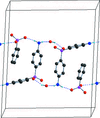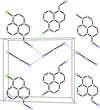issue contents
April 2016 issue

Cover illustration: The crystal structure of boron subphthalocyanine chloride (Cl-BsubPc) has been redetermined with a higher precision 41 years after its original publication, using large single crystals grown via slow train sublimation and diffracted at several temperatures. Intermolecular ![[pi]](/logos/entities/pi_rmgif.gif) -
-![[pi]](/logos/entities/pi_rmgif.gif) and halogen-
and halogen-![[pi]](/logos/entities/pi_rmgif.gif) (B-Cl
(B-Cl
![[pi]](/logos/entities/pi_rmgif.gif) ) interactions are discussed with reference to the Hirshfeld surface. See Virdo, Lough & Bender [Acta Cryst. (2016), C72, 297-307].
) interactions are discussed with reference to the Hirshfeld surface. See Virdo, Lough & Bender [Acta Cryst. (2016), C72, 297-307].
research papers




























 journal menu
journal menu































